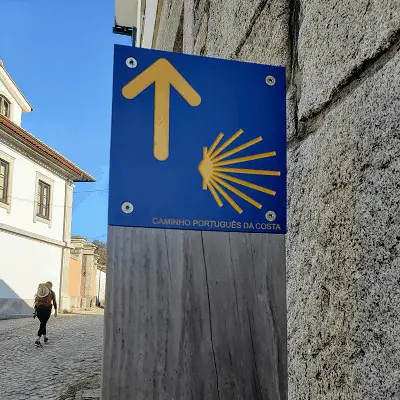
You’ve bought your toe socks and done some training walks with your backpack. The Camino is really happening. But, what’s the deal with the Portuguese Camino Coastal route stages?
Before you can take your first step toward Santiago de Compostela, you’ve got to have a plan for the Portuguese Camino stages so that you feel prepared for your pilgrimage.
After reading this post, you’ll know what walking the Coastal Camino from Porto entails.
On the fence about the Portuguese Way? Read this post so that you can decide if the Portuguese Camino Coastal route is the right Camino for you.
Related Reading:
- Everything You Need to Know About the Portuguese Camino Route
- How Much Does the Portuguese Camino de Santiago Cost?
- The Ultimate Camino Packing List {Free Printable Checklist}
- 25 Insanely Useful Tips for Hiking the Camino de Santiago
Portuguese Coastal Camino from Porto

When it comes to the Camino de Santiago, many people’s minds jump right to the storied French Way. However, that’s starting to change.
More and more pilgrims are electing to walk other Camino trail routes. The Portuguese Way is quickly becoming the second most popular Camino route.
Pilgrims walking the Portuguese Way must choose between the Portuguese Camino Central route and the Portuguese Camino Coastal route. About 30% of pilgrims decide to walk the coastal route.
Read why I chose to take the Portuguese Coastal Camino from Porto to Santiago de Compostela so that you can see if it’s the right Camino for you:
- A desire to do something different
- After walking the last 100 km of the French Way in Sept. 2016, I wanted to get off the beaten path and try a less popular route.
- The ideal length of time
- Since I had a little less than three weeks to spend on the Camino, I wanted to choose a route I could walk the entire length of. Coming in at 12 total walking days, the Portuguese Camino Coastal route fit the bill.
- Ocean views & the chance to see two countries
- I loved the idea of following the coast and walking from one country to another.
Portuguese Camino Stages: My Experience
The Portuguese Camino Coastal route has a total distance of 280 km (174 miles).
In Oct. 2019, I walked the Portuguese Camino Coastal route from Porto to Santiago de Compostela. From start to finish, the journey took me 13 days. That consisted of 12 walking days and one rest day.
For reference, on the days I was walking, I averaged just under 15 miles/day.
Bookmark this post for later so that you always know where to find the details you need for walking the Portuguese Camino Coastal Route stages.
After reading this post, you’ll have:
- A day-by-day breakdown of what to expect on the Portuguese Way
- Information about albergues on the Camino and other accommodation
- Pilgrim’s tips you won’t find anywhere else
Portuguese Camino Coastal Route Stages
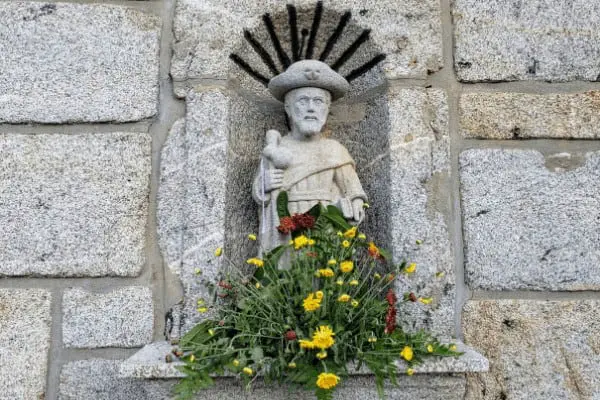
This post is for pilgrims to use as a guide for their own Portuguese Camino. The stages, distances and accommodation are what worked for me, but feel free to make adjustments and substitutions in order to better fit your needs.
After all, this is YOUR Camino.
Day 1: Porto to Angerias (23.4 km)
If you haven’t visited Porto before, you should consider spending at least a couple of days exploring. It’s one of my all-time favorite cities in Europe.
Officially, the Portuguese Camino begins at Sé Cathedral. You can buy your pilgrim credentials there starting at 9 a.m. each morning.
From Sé Cathedral, you make your way down to the Rio Douro and follow the river out of the city. This is the Senda Litoral (Literal Way), and it’s the best way to get out of Porto regardless of whether you’re walking the Central or Coastal route.
What to Expect
This first day of walking keeps you very close to the coast. In fact, much of the Camino follows the boardwalk over the beach.
Pilgrim’s Tip
Trying to get out of Porto can be a little overwhelming with all the traffic and people.
Rather than relying on other pilgrims, use common sense to know which direction to follow the river. The sun rises in the east and sets in the west. The Atlantic Ocean is to the west!
Accommodation
Parque de Campismo Orbitur Angeiras (private)
- €22 for a bungalow with shared bathroom (€11 each)
Many pilgrims will walk to the municipal albergue in Labruge, but Vanessa (who I met on my way out of Porto) and I decided to share a bungalow in Angeiras.
While staying in a muncipal albergue is a quintessential pilgrim experience to have, you might appreciate a good night’s sleep in a more private setting after your first day on the Camino.
Day 2: Angerias to Praia de Estela (24.1 km)
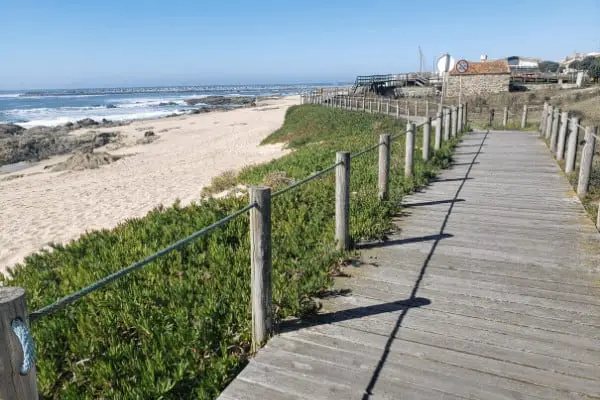
Like the first day, you spend a lot of day 2 following the boardwalk. While the views are nice, walking on the wooden planks can be tough as your body adjusts to the Camino.
What to Expect
As you follow the coast, you’re likely to spend some time (if not all your time) walking into the wind. Just warning you.
You’ll get a break from the when you walking through the quaint historical center of Vila do Conde.
Pilgrim’s Tip
The boardwalk is popular with runners and bikers, so be sure to listen for them coming up behind you and try to stay to one side.
Accommodation
Campismo Orbitur Rio Alto (private)
- €22 for a bungalow with shared bathroom (€11 each)
If you stay in any private albergue along the Portuguese Camino, make it this campground. The chef will whip you up the best meal of your entire Camino.
Day 3: Praia de Estela to Castelo do Neiva (21.2 km)
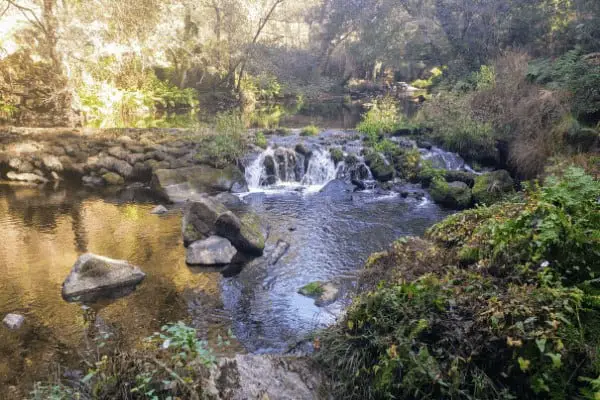
After two days of following the boardwalk, day 3 was a nice change of pace. It’s a lovely mix of coastal views, small towns and forest trekking.
Pilgrim’s Tip
Rather than eating a meal in town, grab a sandwich to go and eat by the waterfall just before Castelo do Neiva.
You’ll need to climb down to the waterfall, but it’s worth it.
Accommodation
Albergue de Castelo do Neiva (municipal)
- €6
This municipal albergue is very clean, and the staff is helpful.
If you’re planning on cooking, just know the supermarket isn’t close by or even along the Camino. Pick up dinner ingredients on your way here when you’re passing through one of the other towns.
Day 4: Castelo do Neiva to Carreço (22.1 km)
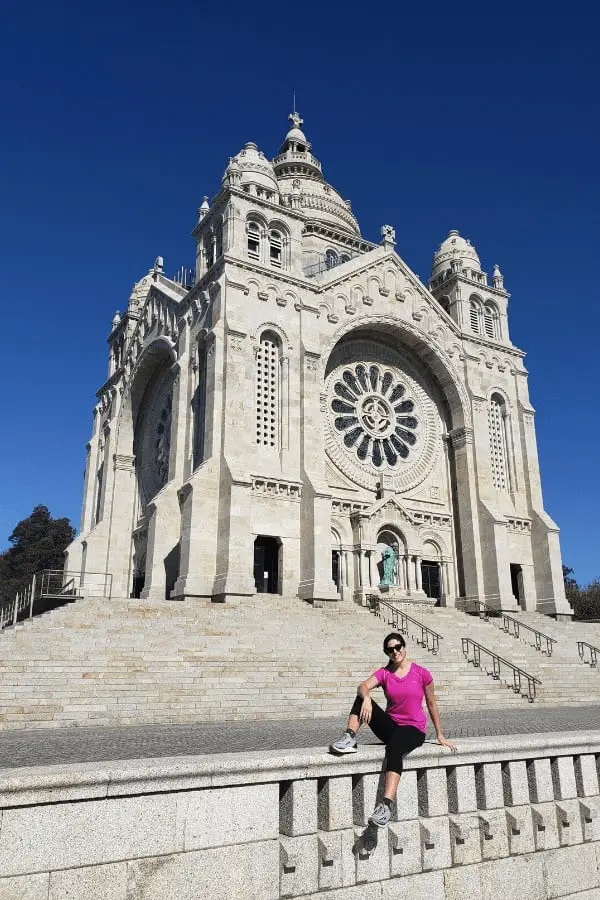
You might’ve seen it written that the Portuguese Camino Coastal route stages are mostly flat, but after day 4, you’ll strongly disagree.
What to Expect
Day 4 has lots of elevation change, especially if you climb up to the Santuario de Santa Luzia.
In addition to walking through the forest and towns, this day featured the bridge from hell. It’s very long and very busy. Scared of heights? Consider getting a ride across it.
Pilgrim’s Tip
Although it’s out of the way to climb up to the Santuario de Santa Luzia, you should take the time to do so. It’s challenging, but the sweeping views are worth it.
Of course, you can always take the funicular to the top.
Once you’ve rested at the top, it’s not difficult to find your way back down to the Camino. There is a trail on the opposite side of the church from the stairs next to the funicular. The trail is on Google Maps.
Accommodation
Casa Do Adro (private)
- €15
This was my favorite albergue on the Portuguese Camino. Paying a few extra euros meant we got to sleep with actual sheets on the bed.
There’s also a washing machine here and a lovely courtyard for relaxing.
Day 5: Carreço to A Guarda (23 km)
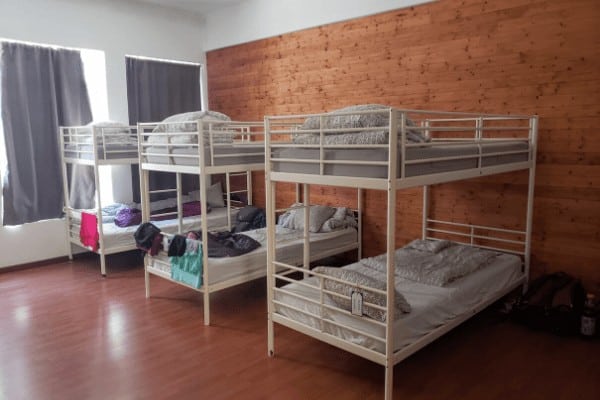
Day 5 is a big day because you’re crossing into Spain. You’ll catch the ferry in Caminha, and it’s just a short ride to A Guarda.
Pilgrim’s Tip
There are four to six ferries every day from Caminha to A Guarda. One ticket costs €1,50.
When you cross into Spain, don’t forget to add an hour.
Accommodation
Albergue Peregrinos (municipal)
- €5
Day 6: A Guarda to Villadesuso (16.8 km)
At this point in my Camino, I was suffering from shin splints and opted for a shorter day.
In Stingy Nomads’ Portuguese Camino Coastal route stages post, they suggest walking from A Guarda to A Ramallosa. That’s a whooping 33 km, which you might also prefer to break up into two days.
Pilgrim’s Tip
When you need to rest on the Camino, do so. There’s no shame in stopping short of your intended destination.
Accommodation
Alojamiento Camino Portugues Oia
- €35 for double room with shared bathroom (€17.50 each)
Day 7: Villadesuso to Nigrán (23.3 km)
Day 7 offers stunning views of the coast, and you also get to do some walking through the forest.
Pilgrim’s Tip
Staying in Nigrán? Order pizza from the place just down the street from El Retiro.
Accommodation
- €30 for double room with private bathroom (€15 each)
Day 8: REST DAY
After two tough days, I desperately needed a rest day in Nigrán.
Originally, I hadn’t planned on taking any rest days on the Portuguese Camino, but with my shin splint making it nearly impossible to walk, it was necessary.
Best Places to Take a Rest Day on the Portuguese Camino
If you want to take a rest day on the Portuguese Camino, there are much better places than Nigrán. Here are the towns you should think about spending an extra day in:
- Caminha, Portugal
- Oia, Spain
- Baiona, Spain
- Pontevedra, Spain
Accommodation
- €30 for double room with private bathroom (€15 each)
- There’s a restaurant/bar in the hotel.
Day 9: Nigrán to Redondela (30.7 km)
After our rest day in Nigrán, Vanessa and I wanted to catch up to one of our friends who was ahead of us on the Camino. That meant our longest day of walking.
What to Expect
You’ll spend much of day 9 just making your way through Vigo. It’s a very big city, so if there’s anything you need to buy you’ll have the best chance of finding it there.
Instead of walking straight through Vigo, take the detour through the city’s main park. There are signs showing the way.
Accommodation
- €40 for double room with private bathroom (€20 each)
- On a map, it may not seem like this hotel is far off the Camino, but it’s a very steep descent.
Day 10: Redondela to Pontevedra (29.2 km)
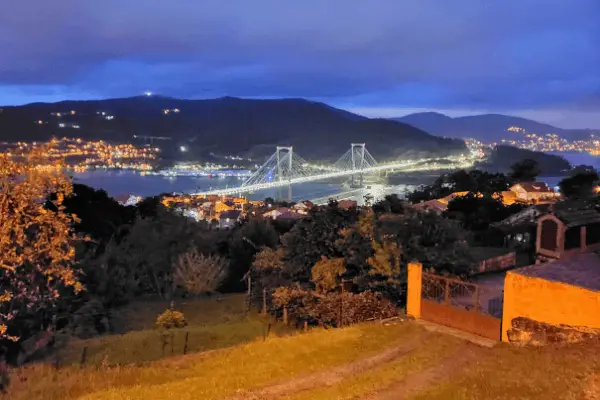
Instead of climbing back up to the Camino, we walked along the highway and it eventually reconnected with the trail.
This kind of highway walking is why it’s a good idea to have something reflective for your backpack.
What to Expect
At this point, you’ll see a significant increase in the number of pilgrims. Since there’s approximately 100 km to Santiago de Compostela, many are starting in order to earn their Compostela.
Accommodation
Albergue La Virgen Peregrina (municipal)
- €8
- Even in the shoulder season, this 60-bed albergue was completely full by 5 p.m.
Day 11: Pontevedra to Caldas de Reis (21.1 km)
Hopefully, you got enough of the coastal views while they lasted. Day 11 takes you through the forest and some small towns.
Accommodation
Albergue Caldas de Reis (private)
- €12 for a bed in a three-person room
When we showed up at the municipal albergue (Posada Doña Urraca) and found out it was full, the guy at the front desk took us next door to a private albergue and set us up in a triple room with access to a shared bathroom.
There are many private albergues with good reviews in Caldas de Reis.
Day 12: Caldas de Reis to Padrón (19.2 km)
You’re almost to Santiago de Compostela!
But since you’re so close, that means there are more pilgrims than ever on the Camino. Plan on staying in municipal albergues? Arrive early to get a bed.
What to Expect
At the start of the Portuguese Camino Coastal route, cafes and albergues are pretty spread out but that’s no longer the case. The closer you get to Santiago the easier it is to find places to eat and sleep.
Pilgrim’s Tip
When you’re in Padrón, don’t forget to eat Spain’s beloved peppers: pimientos de Padrón.
Accommodation
Albergue de Peregrinos de Padrón (municipal)
- €8
- This albergue’s kitchen had very few dishes which made cooking difficult.
- There are just two toilets and two showers (communal) for the women and the same for the men.
Day 13: Padrón to Santiago de Compostela (24.4 km)

Soak up every minute because your time on the Portuguese Camino is coming to an end.
What to Expect
After 13 days on the Camino, there is no better feeling than arriving in Santiago de Compostela.
What was it like for me?
I laughed. I cried. I literally jumped for joy.
Pilgrim’s Tip
Once you’re in Santiago de Compostela, stop in at a supermarket to grab some cervezas for a toast in front of the cathedral.
Accommodation
- €15 for a bed in a four person-room
There’s lots of pilgrim-friendly accommodation in Santiago de Compostela. Depending on the time of year you’re walking, you might want to book something online a few days out to make sure you get something centrally-located.
Portuguese Coastal Camino from Porto
Got questions about the Portuguese Coastal Camino stages? Ask away in the comments.
Want to know more about the Camino de Santiago? Don’t miss these posts!
- Everything You Must Know About the Camino de Santiago
- How to Prepare for the Camino de Santiago in 3 Easy Steps
- Camino de Santiago Cost: How Much Money Do You Need? {French Way}
Psst…Don’t forget to SAVE this post for later!
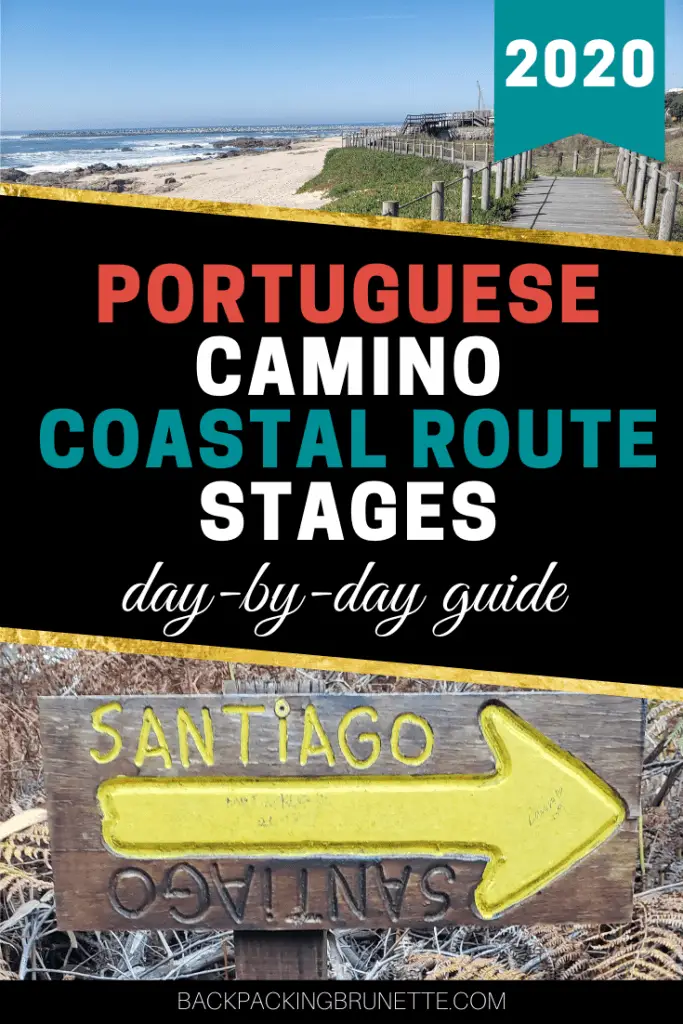
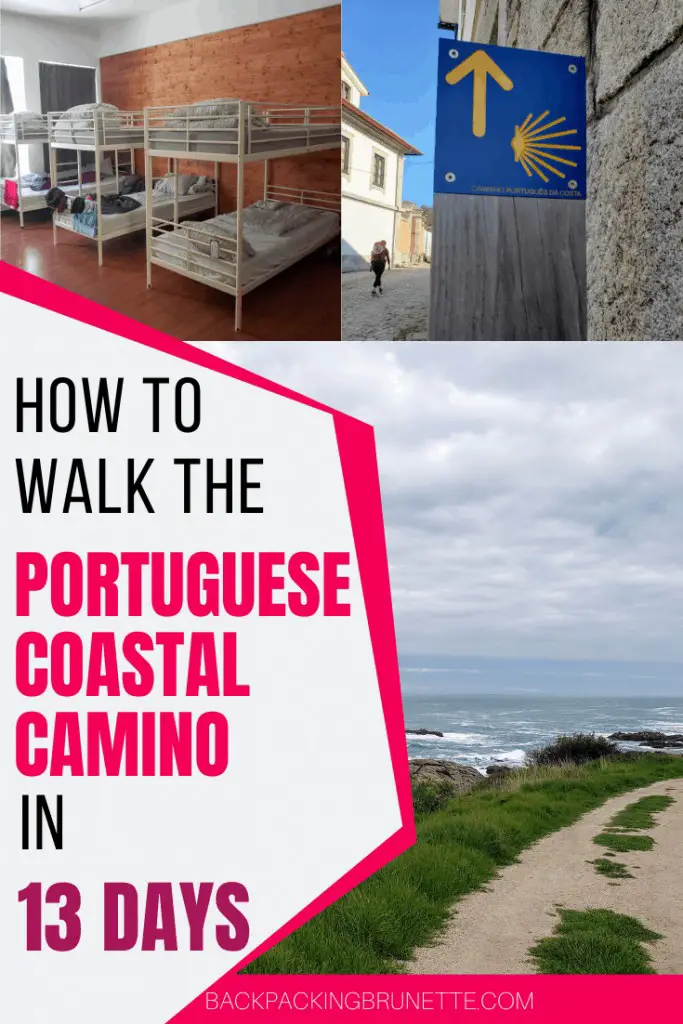
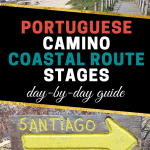
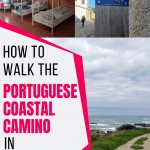
Hi there,
I’ve been reading your info; it’s quite interesting. I’m interested in the Caminho Portugues, that’s how I got to your blog.
I just wanted to tell you that “Litoral” doesn’t mean “Literal” in Spanish or Portuguese. It means “coastal”.
“Literal” means the same as in English, when for example, you read a literal translation of a saying and it doesn’t make sense. It comes from Latin. Both, Spanish and Portuguese are some of the many dialects of Latin, the Language of the Roman Empire.
Cheers and good luck
L
Hi, Ladis!
Thanks for the info & best of luck on your Camino journey 🙂
All the best,
Alex
We may very well have encountered you last October. We arrived in Porto to Santiago Oct 13 and reached Santiago Oct 24. Although we opted for the alternate route from Caminha to Tui, we would have shared the trail from Redondela into Santiago and we surely shared the rain!
I’ve finally gotten to my GoPro videos and photos and have been posting them on Instagram and my YouTube channel so if you want to see some familiar views take a look. Instagram is stevefoster2.
Nice article here.
Thanks for reading, Steve & if your Camino experience was anything like mine, it was the adventure of a lifetime!
Awesome ! Obrigado ?
You’re welcome! Buen Camino!
Thanks for all your posts. We are hoping to walk the Portuguese Coastal in May 2022. We are hoping to send our packs along each day. It seems that there is pack couriers in Spain but do you know if there are couriers along the Coastal way on the Portuguese side? Thanks,
Hi ya Alex. This route is the very one I have been researching. Then covid delayed everything for 2020. Planning for 2022 now, spring or September, have not decided. Suggestions?
Anyway, may have to go alone now though, but it seem many people go solo, like yourself.
Curious how you booked your private accommodations for the night. Was it booking.com?
Where can I add the spiritual variant on my route. I read somewhere it adds an extra day to the journey
Thanks
Just read your blog. Thanks so much. Keep thinking about going in the next few weeks though worry about weather, rain??? Keep feeling life is flying by waiting for things to be just right. Hard to know what spring will be. That said, is there a bus do you know from Caminha into Santiago if weather starts getting worse or my husband might go but not want to walk it all. Really having a hard time finding out a schedule, covid says it impacts. any hints? thanks
After completing the pilgrimage, how long was the recovery period? We want to vacation after.
Hi, hello
Enjoyed reading your experience. We are planning to do our camino in 2023.
2 retired couple on our early 60s. Can you give us advise on the best month to do it. What is the best map/guide that we can use to plan our camino, that will show us the towns along the way & the accommodations. Thanks in advance.
Rico
Hey, just wanted to let you know, the santuario in viana do castelo is Santa Luzia, not Santa Luiza. Luz like light. I spent all my summers growing up in Portugal and visited that santuario many times. 🙂
Thank you for pointing that out, Cynthia!